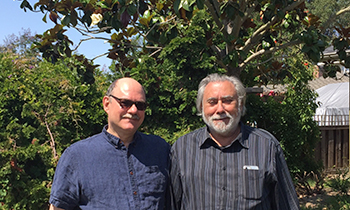Campus News
UCSC arts research center awarded $250,000 grant from U.S. Forest Service
The U.S. Forest Service has awarded a $250,000 grant to the Center for the Study of the Force Majeure, a research center based in the Arts Division at UC Santa Cruz.


The U.S. Forest Service has awarded a $250,000 grant to the Center for the Study of the Force Majeure, a research center based in the Arts Division at UC Santa Cruz.
Founded by Newton and Helen Mayer Harrison, research professors in UCSC’s Digital Arts and New Media Program (DANM), the Center for the Study of the Force Majeure brings together artists and scientists to design ecosystem-adaptation projects in critical regions around the world to respond to climate change.
The center will use the grant to study the economic feasibility of developing an innovative forest industry cluster near Reno, Nevada.
Titled the “Western Nevada and Central Sierra Nevada of California Regional Wood Utilization Team,” the project will estimate the supply of wood biomass in the area east of the central Sierra crest and in western Nevada, and assess the possibility of producing wood products from that supply.
Funds will be used to support the creation and management of a special committee, led by Joshua Harrison, co-director of the UCSC center. The multidisciplinary, bi-state team will then cultivate local businesses in the area that can generate useful products from wood biomass.
The aim of the grant–part of $8.3 million in distributed funds just announced by the U.S. Forest Service–is to stimulate the removal of hazardous fuels from forests to reduce the risk of catastrophic wildfires and promote forest health, while at the same time spurring the economic development of rural communities.
“Our first step is to get a much better estimate of the supply–the amount of timber by species along with brush and other biomass available in the WUT (Wood Utilization Team) region which covers a big chunk of the Eastern Central Sierra around Lake Tahoe and a matching section of Western Nevada,” said Harrison. “We need to understand better how much wood and woody biomass is available using an environmental analysis that protects endangered species habitat, wetlands and riparian areas, and prioritizes 10-inch and smaller diameter trees–in effect what we’re calling the ‘environmental cut.”
“Our next step is to take that supply information and work with some partners to identify a range of potential uses–from soil additives, to pallets, fence posts, pellets, wood chips, traditional timber and a range of manufactured woods, along with the economic potential of each use.”
“Finally, we will take our research and add market need and economic analysis to build a strategic economic overview which we will publish,” he added.
Harrison noted that in addition to working with a range of public and private partners to find specific users and manufacturers, the end goal of the project is to have both California and Nevada become states with a “Wood First” orientation, where they officially rely upon renewable wood-based resources for major construction and housing projects.